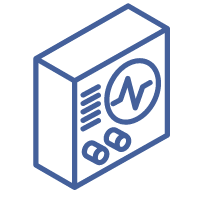
Skyworks 590WB-BDG
590WB-BDG
0603 (1608 Metric)
46106063-590WB-BDG
XTAL OSC PROG XO CML 1.8V 25PPM
- Mounting TypeSurface Mount, MLCC, Epoxy
- Package / Case0603 (1608 Metric)
- PackageTape & Reel (TR)
- MfrVishay Vitramon
- Product StatusObsolete
- Voltage Rated
RATED voltage is the voltage on the nameplate - the "design point" for maximum power throughput and safe thermal operation.
100V - Base Product Number590WB
- Frequency Stability (Total)±50ppm
- Operating Temperature
The operating temperature is the range of ambient temperature within which a power supply, or any other electrical equipment, operate in. This ranges from a minimum operating temperature, to a peak or maximum operating temperature, outside which, the power supply may fail.
-55°C ~ 150°C - SeriesVJ High Q
- Size / Dimension0.063 L x 0.031 W (1.60mm x 0.80mm)
- Tolerance±0.1pF
- Temperature Coefficient
The resistance-change factor per degree Celsius of temperature change is called the temperature coefficient of resistance. This factor is represented by the Greek lower-case letter “alpha” (α). A positive coefficient for a material means that its resistance increases with an increase in temperature.
C0G, NP0 - TypeXO (Standard)
- ApplicationsRF, Microwave, High Frequency
- Capacitance3.3 pF
- Voltage - Supply1.8V
- Frequency Stability
the variation of output frequency of a crystal oscillator due to external conditions like temperature variation, voltage variation, output load variation, and frequency aging.
±25ppm - OutputCML
- FunctionEnable/Disable
- Base ResonatorCrystal
- Current - Supply (Max)110mA
- Failure Rate
the frequency with which an engineered system or component fails, expressed in failures per unit of time. It is usually denoted by the Greek letter λ (lambda) and is often used in reliability engineering.
- - Lead Spacing
the distance between two baselines of lines of type. The word 'leading' originates from the strips of lead hand-typesetters used to use to space out lines of text evenly. The word leading has stuck, but essentially it's a typographer's term for line spacing.
- - Current - Supply (Disable) (Max)75 mA
- Programmable Type
These include Field Programmable Logic Devices (FPGAs), Complex Programmable Logic Devices (CPLD) and Programmable Logic Devices (PLD, PLA, PAL, GAL). There are also devices that are the analog equivalent of these called field programmable analog arrays.
Programmed by Digi-Key (Enter your frequency in Web Order Notes) - Available Frequency Range125 MHz ~ 214.999 MHz
- Lead Style-
- Spread Spectrum Bandwidth
In telecommunication and radio communication, spread-spectrum techniques are methods by which a signal (e.g., an electrical, electromagnetic, or acoustic signal) generated with a particular bandwidth is deliberately spread in the frequency domain, resulting in a signal with a wider bandwidth.
- - FeaturesHigh Q, Low Loss, Epoxy Mountable
- Height Seated (Max)-
- Thickness (Max)0.036 (0.92mm)
- Ratings-








